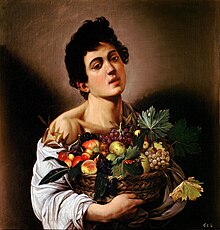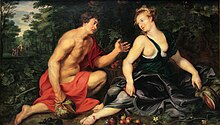Voltumna
Voltumna is an Etruscan deity . According to Varro , he was the chief deity in the Etruscan religion , but his exact function is unclear. The Romans took it over from the Etruscans under the name Vortumnus, later Vertumnus . He shares some characteristics with the Etruscan high god Tinia .
Word history
According to research, the development of the name Voltumna to Vertumnus is possibly based on a folk etymology based on the Latin vertere (= change, turn away, damming), now apparently the main characteristic of the god in Rome, to whom, according to Ovid, flood protection was ascribed . The feminine ending -a , which the Romans certainly perceived as strange for a male deity and which has no gender character in Etruscan , was replaced by the Latin masculine ending -us , and there was also a change in liquid from l to r , as it did in Latin and Greek occurs. It is unclear whether Voltumna was an Etruscan word at all and not just an auxiliary Roman name, because it has not been passed down in the 7500 mostly very short texts in the Etruscan language from the 8th century BC to the 1st century AD. The prefix vol- occurs frequently in Etruscan place names such as Volsinii , Volaterrae , Volturno , Volci and in tribal names such as Volsker . Vel is according to the findings of the dedications a common equity or gentile name and is considered as a derivative of said historical place names with Vel- / v . All in all, the history of words already demonstrates the transitory character of this mythological figure oscillating between Etruscan and Roman.
Mythological representation, function and historical background

The Etruscan Voltumna seems to have originally been an ancient earth god who was also responsible for the change of the seasons, and he was later merged with the figure of Tinia , the actual high god of the Etruscans, as often occurs in mythologies . after the Romans plundered the sanctuary of Voltumna and kidnapped the statue of the gods to Rome. Marcus Terentius Varro speaks of a Vertumnus , who calls him the “Deus princeps Etruriae”, the highest god of Etruria, and under this name he was worshiped by the Romans. Libation altars for libations, which were reserved in Greece for the cult of chthonic deities, as the sacrifice can penetrate into the depths of the earth through an opening in the altar, are typical of the cult of Voltumna and Tinias . At his side one usually sees Uni, the goddess of Veji , who is attributed to Tinia as wife.
According to Roman sources ( Livy ), the twelve peoples of Etruria of the so-called Twelve Cities Association affirmed their togetherness every year in a solemn ceremony in the sanctuary of Voltumna near Volsinii , the Fanum Voltumnae . Even during crises between the individual cities or between these and Rome, the place served as a center, where one tried to settle the conflict or try to win the support of other cities. The so-called “Concilium Etruriae” of Livy met there in the sanctuary under the direction of a priest, which, as a superordinate ethnic association of Etruria, also dealt with political problems in addition to religious and organizational issues.
According to ancient tradition , the founder of the cult in Rome is already Servius Tullius , the legendary sixth king of Rome and possibly an Etruscan. In any case, the Romans considered Voltumna so important that after their victory over Volsinii (today Bolsena ) in 264 BC, at the instigation of the general M. Fulvius Flaccus, He had a temple built for him on the Roman Aventine and thus deprived the defeated Etruscans of their most important religious foundation, especially since, although no other looting occurred (with the exception of Rusellae and Volsinii), they also robbed the entire temple furnishings of Volsinii (according to the Naturalis historia of Pliny there were 2,000 statues) and transferred to the new Roman sanctuary. The process also marks the final political end of the Etruscans, because with that they had lost their spiritual center and gradually became part of the Roman state association.
Interpretation problems and mythological development
The main problem with the interpretation is that none of the already few surviving and interpretable Etruscan inscriptions provide any clues as to what exactly were the functions of Voltumna in the Etruscan religion, as it is to be classified in its cosmic system, because his name is missing on the bronze liver from Piacenza . His relationship to the god Tinia is therefore unclear. On the other hand, there are many Latin sources, which mostly contribute to confusion rather than clarification, especially since they often differ greatly from one another and sometimes only reflect the current view, which was Roman, not Etruscan. Livy z. B. describes the Fanum Voltumnae , but he never locates this main Etruscan shrine, and it has not yet been clearly established where it was. Some scientists suspect that it was near the present-day Italian city of Bolsena , near the Etruscan capital of Volsinii , which was conquered by the Romans . In any case, the Romans took over parts of the world of gods from the Etruscans (as well as from the Greeks), gradually modified them mythologically and fitted them into their worldview, as often occurs with such intercultural transitions and as Cavendish did, e.g. B. for the mythology of the Romans. These “double gods” fluctuate again and again from one function and iconography to the other, but in the Roman Vertumnus the character of the high god, whose position was now occupied by Jupiter , was lost, only a few aspects of fertility remained. Ovid later associated Voltumna with the fruit goddess Pomona. It also seems to have been very popular with the Romans, because they dedicated a festival of their own, the Vertumnalia , which were celebrated in the first half of August.
Representations and text documents

A youthful bronze statue of Vertumnus / Voltumna stood in Rome on the Vicus Tuscus, the "Etruscan Street". Apparently the local fruit traders saw him as their patron saint, especially since he was mythologically related to the fruit goddess Pomona and was also worshiped as the god of trade. The beet-shaped stylized lightning bolt in his hand, which he also wielded due to his merging with Tinia, was apparently misunderstood as a fruit. Sextus propertius mentions that this bronze statue replaced an older wooden statue of the "Vortumnus", which stood in a simple shrine called "Signum Vortumni" (sign of the Vortumnus), which was decorated according to the season. The statue's base plate was discovered in 1549, possibly still in its original location, but has since disappeared. The inscription referred to a restoration of the statue in the early 4th century AD: VORTUMNUS TEMPORIBUS DIOCLETIANI ET MAXIMIANI (Vortumnus at the time of Diocletian and Maximian ).
Ovid also recalled in his poem “Fasti” (festivals) a time when the Roman Forum , near which the Vertumnus statue stood, was just a reed-covered swamp: “That god, Vertumnus, whose name has many forms, was his name not yet, because he was not yet driving the water upstream ”. (A play on words with Latin vertere = (turn away); Ovid is probably referring to the old name Voltumnus and here mixes the function of Tinia as a flood protection god with that of Voltumnus).
In the Metamorphoses of Ovid 622 in book XIV - 697 the Vertumnus even a love story with the Roman goddess of fruit Pomona imputed. This is actually a dryad , to which he returns in the form of a handsome youth after an affair and after all sorts of transformations - he also appears as an old woman. This is a strong indication of his old character as a changing god of vegetation and his former dual nature as Tinia / Voltumnus. The motif as such was very popular in art up to the Renaissance and Baroque periods.
literature
- Gerhard J. Bellinger: Knaurs Lexikon Mythologie. Droemer Knaur Verlag / Weltbild Verlag, Munich 1999 / Augsburg 2001, ISBN 3-8289-4154-0 .
- Richard Cavendish, Trevor O. Ling (Ed.): Mythology. An illustrated world history of mythical-religious thought. Christian Verlag, Munich 1981, ISBN 3-88472-061-9 .
- Fernand Comte: Myths of the World. WBG, Darmstadt 2008, ISBN 978-3-534-20863-0 .
- Mauro Cristofani et al. (Ed.): The Etruscans. Mysterious culture in ancient Italy. Belser Verlag, Stuttgart 1995, ISBN 3-7630-2330-5 .
- Gonzalo Fontana Elboj: Ager: estudio etimológico y functional sobre Marte y Voltumna . Departamento de Ciencias de la Antigüedad de la Universidad de Zaragoza, 1992, ISBN 84-600-8279-2 . (in spanish language)
- Martello Maggiani: Science and Religion. In: Mauro Cristofani et al. (Ed.): The Etruscans. 1995, pp. 136-151.
- Friedhelm Prayon : The Etruscans. History - religion - art. 4th edition. Verlag CH Beck, Munich 1996, ISBN 3-406-41040-5 .
- Helmut Rix : Writing and Language. In: Mauro Cristofani et al. (Ed.): The Etruscans. 1995, pp. 210-238. Chapter: Writing and Language.
- Erika Simon : Etruscan cult deities. In: Mauro Cristofani et al. (Ed.): The Etruscans. 1995, pp. 152-167. Chapter: Etruscan cult deities.
Web links
Individual evidence
- ↑ Bronze liver of Piacenza (Eng.)


